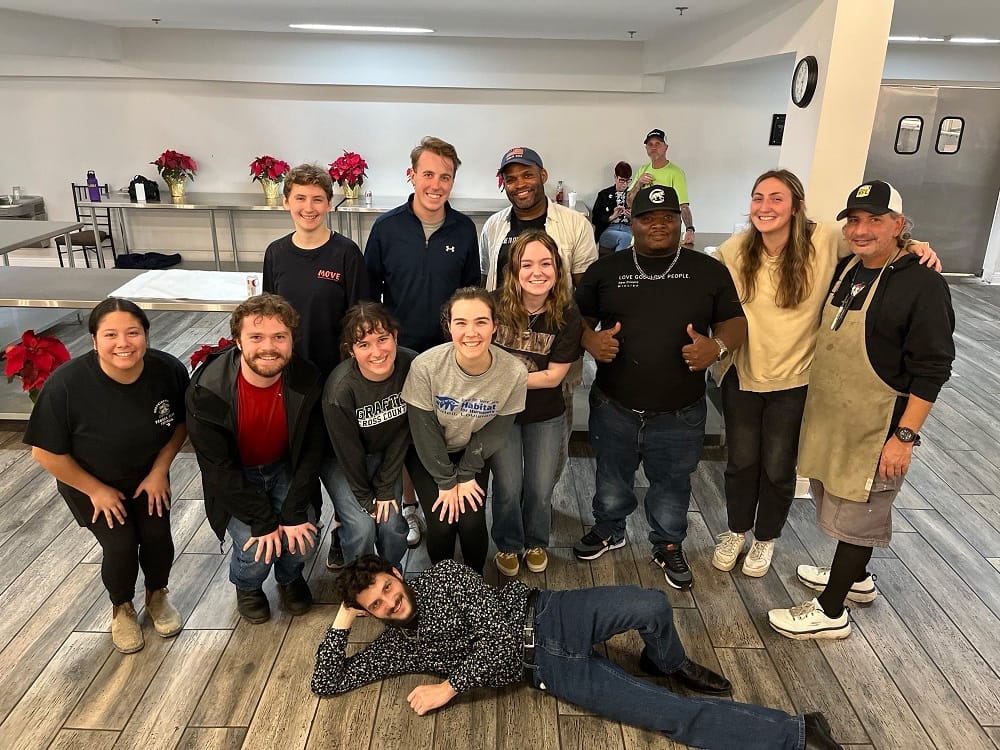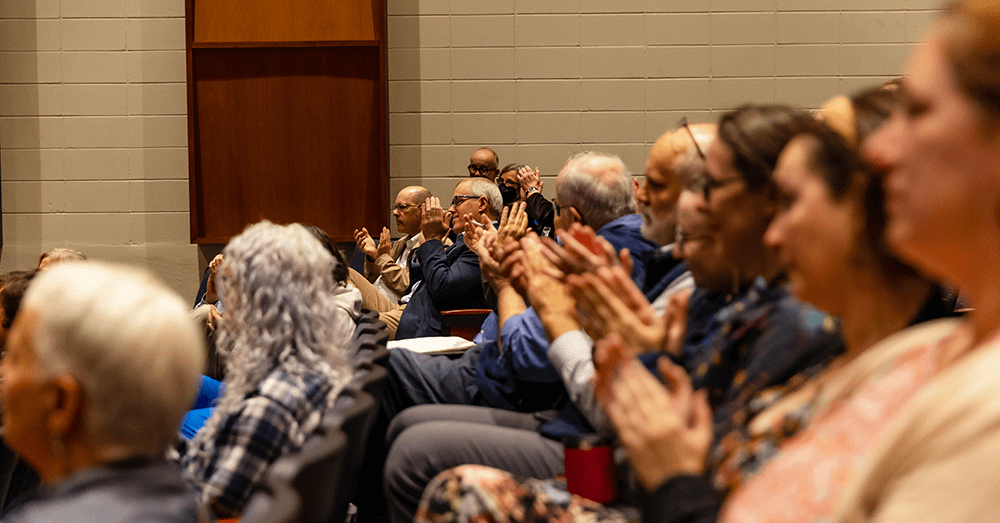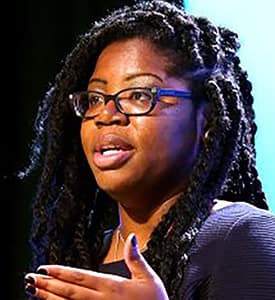Panel weighs how times, standards change on critiquing Black art themes
Three faculty scholars and student talk about Tuesday's showing of "Dreamgirls" -- a 2006 film loosely based on history of the early Motown super-group the Supremes
Panelists discussing the 2006 film Dream Girls Wednesday in the Roy Room seemed to suggest that critiques of Black representation in film and videography must take care to avoid the error of presentism – that is, a temptation to judge works of past eras by today’s more evolved standards.
The Dreamgirls panel on Wednesday night did just that, and while the conversation remained academic, the curiosity and conversation among attendees and panelists was palpable. The movie is a fictionalized loose retelling of the story of the Supremes, the famous Motown vocal group of the 1960s and ‘70s.
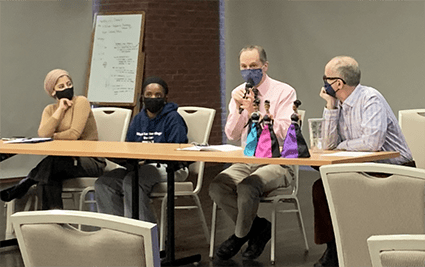
Panelists Wednesday discussing the film “Dream Girls” were, from left, Professor Inaash Islam, student Kaltuma Ibrahim ’25, Professor Nat Lew and Professor Peter Harrigan. (photo by Kaylee Sayers ’23)
As a part of the Martin Luther King Jr. Convocation, Saint Michael’s College hosted a showing of the 2006 film Dreamgirls on Tuesday and held a follow-up panel for the film Wednesday evening. It was an intimate event, with impassioned presentations and thoughts about the film coming from both panelists as well as audience members.
Jeson Li ’23, emcee and MLK Jr. Society member, introduced the four panelists: Professor Peter Harrigan of the Theatre Department, Professor Nat Lew of the Music Department, Professor Inaash Islam of the Sociology Department, and student/member of the MLK Jr. Society Kaltuma Ibrahim ‘25. Each panelist focused on different aspects of the film, giving the attendees valuable historical context for the film as well as complex social issues to consider.
Lew gave a well-informed oration on the film’s namesake play Dreamgirls on Broadway, and though he admitted that his realm of study and personal listening habits did not include the music within the film, he gave a good depth of expertise on the history of Black presence in film and musical theater.
He mentioned the question of whether or not the film was an example of “Black ventriloquism” due to the fact that the producers, writers, and directors were ethnically white men, or whether the film still retained its value due to the time it was produced and the goal it was attempting to accomplish. Lew spoke of the nuanced conversations happening around well-meaning non-Black artists conceiving of Black stories and how it can be damaging, but “is it damning?” No matter who is on stage, Lew said, “white men have usually written the words coming out of their mouths.”
Though Lew encouraged attendees not to damn the movie for having a white director, he conceded that he believed “there may have been other ways to tell this story… We must insist that African-American women [also] tell their own stories.”
Islam had a similar take on the film, though she viewed it through a sociological lens. “I am a race scholar and a gender scholar… I do have background in analyzing Black women’s representation in media,” she said. Islam lauded the film for its ability to “center Blackness without juxtaposing the world of Blackness with the world of whiteness… [the film] locates the white role in its periphery.”
Islam had a similar observation to Lew in that the time the film was produced was a moment when the push for diversity was not as strong as it is today. Lew and Islam both cautioned against presentism, but instead encouraged attendees to find some sympathy for the effort to create a valuable piece of art even if the players behind the camera were not Black.
That being said, Islam delved into how difficult it is for film, literature, and other art to avoid harmful tropes linked to Black women even when they are trying to avoid those stereotypes. She laid out the tropes of the “the mammy” which is the caregiver/nanny stereotype, “the matriarch” which is the domineering maternal figure stereotype, “the sapphire” which is the “angry Black woman” stereotype, and “the Jezebel” which is the sexually promiscuous stereotype. She went through the film, combing through the characters and mentioning how the film did a good job avoiding these images of Black women even if there are some echoes of them here and there.
The image of the “strong Black woman,” Islam continued, “is portrayed in the media as the ideal Black woman.” The “strong Black woman” image celebrates resourcefulness and class all while never letting adversity get her down. “We see this at the end of the film with all the Dreamettes being successful… but this image can also be damaging.” She explained how confining forms of representation create an expectation on Black women that is often unachievable and damaging. “Taking a note out of the film itself… we as audience members need to allow Black women to be themselves… not confine them to images,” she said.
Ibrahim, the student panelist, observed the depiction of “misogynoir” in the film, which is a distinctive form of prejudice against Black women in particular. She noted that such a mindset, however, was a common part of society around the Vietnam War, the period when the film takes place. The misogynoir of the film stood out to her as a strong early impression of the film.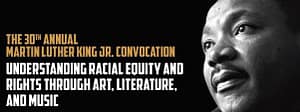
Harrigan gave the audience unique background on the Supremes, the vocal group from the late-‘60s into the ‘70s on which the film Dreamgirls was loosely based. He discussed the stylistic choices, particularly the dresses, worn by the Supremes and how a red dress shown in Dreamgirls was essentially a nod at a nearly identical dress worn by the Supremes. He passed around a photo book of the Supremes called Supreme Glamour which allowed audience members to see the hairstyles as well as the dresses that made up the look of the group.
Lew and Harrigan both celebrated and critiqued the film on its costuming, because the Supremes had heavy beading and bejeweling in their clothes that was perfect for color tv, so that aspect of the film is accurate. However, one criticism comes from the film’s prioritization of “glitz over substance,” and the missed opportunity to go in depth on the motivations, inner lives, and complexities of these characters.
Harrigan also acknowledged that the Supremes made huge impacts on Black America by appearing on the Ed Sullivan show 15 times, performing at the White House following the assassination of Dr. Martin Luther King, Jr., and being generally family-friendly celebrities. That being said, Harrigan explained, they toured expansively in Europe because there “they were superstars, not ‘Black superstars.’” Their treatment was elevated in Europe compared to America.
Harrigan also noted the “double diva” entendre of casting Beyoncé in the role associated with Diana Ross in the film, because Diana Ross was the “Beyoncé of her time.”
The panel was a riveting conversation overall with the Q&A session pushing the discussion late. Students in attendance were highly involved and participatory in the discourse, and the occasion was a satisfying mid-week event in the continuing MLK Convocation.
